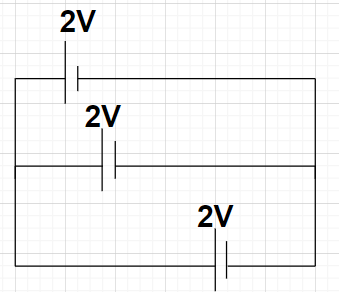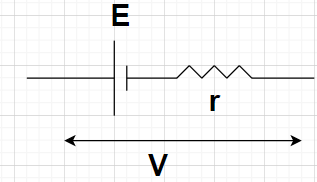
Answer
485.4k+ views
Hint: Here, we will proceed by defining the term electromotive force (emf). Then, we will write down the relation between the terminal potential difference (V) and emf (E). Then, we will write the important concept when cells of the same emfs are connected in parallel.
Complete Step-by-Step solution:


Given, emf of the first cell = emf of the second cell = emf of the third cell = 2 V
EMF or Electromotive force is defined as the potential difference that develops within an open circuit between the two terminals of a battery. The emf is the theoretical difference between the positive terminal anode and the negative terminal cathode when no current flows through it. The emf tests the energy that is transferred in the cell or a battery to the charge borne. It is the energy in joules which is divided by the coulombs charge. The emf serves as the triggering force for flow of the current.
When internal resistance is considered, then the terminal potential difference is given by
V = E – Ir where V denotes the terminal potential difference, E denotes the emf, I denotes the current and r denotes the internal resistance
Usually internal resistance of a cell is not considered because ε >> Ir. The value of internal resistance changes from cell to cell.
In this case also, there is no mentioning of internal resistance of the cells, So, we will neglect it and we get consider that the terminal potential difference between the terminals is equal to the electromotive force (emf).
When n number of cells each of emf E are connected in parallel with each other, then the net equivalent emf of the system will be equal to the individual emf E
Clearly, the emfs of all the three cells which are connected in parallel are equal. So, the total emf of the circuit will be equal to the individual emf of the cell.
Therefore, the required total emf of the system will be equal to 2 V.
Hence, option C is correct.
Note- Cells are joined end-to - end in sequence, so that the same current flows through each cell. If the cells are connected in series the battery emf is equal to the sum of the individual cells emf. The overall emf of the battery E = ${{\text{E}}_1} + {{\text{E}}_2} + {{\text{E}}_3} + {{\text{E}}_4} + ... + {{\text{E}}_{\text{n}}}$ where ${{\text{E}}_1}$, ${{\text{E}}_2}$, ${{\text{E}}_3}$,…, ${{\text{E}}_{\text{n}}}$ are the emfs of individual cells.
Complete Step-by-Step solution:


Given, emf of the first cell = emf of the second cell = emf of the third cell = 2 V
EMF or Electromotive force is defined as the potential difference that develops within an open circuit between the two terminals of a battery. The emf is the theoretical difference between the positive terminal anode and the negative terminal cathode when no current flows through it. The emf tests the energy that is transferred in the cell or a battery to the charge borne. It is the energy in joules which is divided by the coulombs charge. The emf serves as the triggering force for flow of the current.
When internal resistance is considered, then the terminal potential difference is given by
V = E – Ir where V denotes the terminal potential difference, E denotes the emf, I denotes the current and r denotes the internal resistance
Usually internal resistance of a cell is not considered because ε >> Ir. The value of internal resistance changes from cell to cell.
In this case also, there is no mentioning of internal resistance of the cells, So, we will neglect it and we get consider that the terminal potential difference between the terminals is equal to the electromotive force (emf).
When n number of cells each of emf E are connected in parallel with each other, then the net equivalent emf of the system will be equal to the individual emf E
Clearly, the emfs of all the three cells which are connected in parallel are equal. So, the total emf of the circuit will be equal to the individual emf of the cell.
Therefore, the required total emf of the system will be equal to 2 V.
Hence, option C is correct.
Note- Cells are joined end-to - end in sequence, so that the same current flows through each cell. If the cells are connected in series the battery emf is equal to the sum of the individual cells emf. The overall emf of the battery E = ${{\text{E}}_1} + {{\text{E}}_2} + {{\text{E}}_3} + {{\text{E}}_4} + ... + {{\text{E}}_{\text{n}}}$ where ${{\text{E}}_1}$, ${{\text{E}}_2}$, ${{\text{E}}_3}$,…, ${{\text{E}}_{\text{n}}}$ are the emfs of individual cells.
Recently Updated Pages
If x be real then the maximum value of 5 + 4x 4x2 will class 10 maths JEE_Main

If the coordinates of the points A B and C be 443 23 class 10 maths JEE_Main

What happens when dilute hydrochloric acid is added class 10 chemistry JEE_Main

The quadratic equation whose one root is 2sqrt3 will class 10 maths JEE_Main

If alpha and beta are the roots of the equation x2 class 10 maths JEE_Main

What is the distance between the circumcentre and the class 10 maths JEE_Main

Trending doubts
Fill the blanks with the suitable prepositions 1 The class 9 english CBSE

Which are the Top 10 Largest Countries of the World?

How do you graph the function fx 4x class 9 maths CBSE

Differentiate between homogeneous and heterogeneous class 12 chemistry CBSE

Difference between Prokaryotic cell and Eukaryotic class 11 biology CBSE

Change the following sentences into negative and interrogative class 10 english CBSE

The Equation xxx + 2 is Satisfied when x is Equal to Class 10 Maths

In the tincture of iodine which is solute and solv class 11 chemistry CBSE

Why is there a time difference of about 5 hours between class 10 social science CBSE




